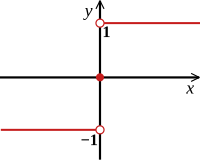Sign function

The sign function helps us understand whether a number is positive, negative, or zero. Imagine a number line that starts from 0 and goes in both directions - to the left and to the right.
When we put a number into the sign function, it looks at the number's value and tells us whether it's positive, negative, or zero. If the number is greater than zero, it's positive. If the number is less than zero, it's negative. And if the number is exactly zero, then the sign function will return zero.
For example, if we put the number 5 into the sign function, it tells us that 5 is positive. If we put the number -2 into the sign function, it tells us that -2 is negative. And if we put the number 0 into the sign function, it tells us that 0 is neither positive nor negative - it's just a neutral number.
So, the sign function helps us quickly figure out whether a number is positive, negative, or neutral without having to look at it in context with other numbers.
When we put a number into the sign function, it looks at the number's value and tells us whether it's positive, negative, or zero. If the number is greater than zero, it's positive. If the number is less than zero, it's negative. And if the number is exactly zero, then the sign function will return zero.
For example, if we put the number 5 into the sign function, it tells us that 5 is positive. If we put the number -2 into the sign function, it tells us that -2 is negative. And if we put the number 0 into the sign function, it tells us that 0 is neither positive nor negative - it's just a neutral number.
So, the sign function helps us quickly figure out whether a number is positive, negative, or neutral without having to look at it in context with other numbers.
Related topics others have asked about:
